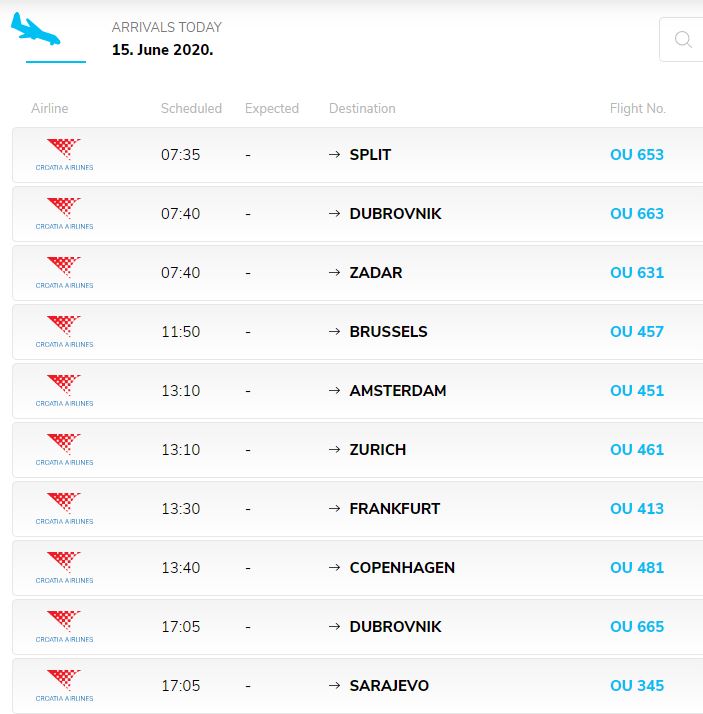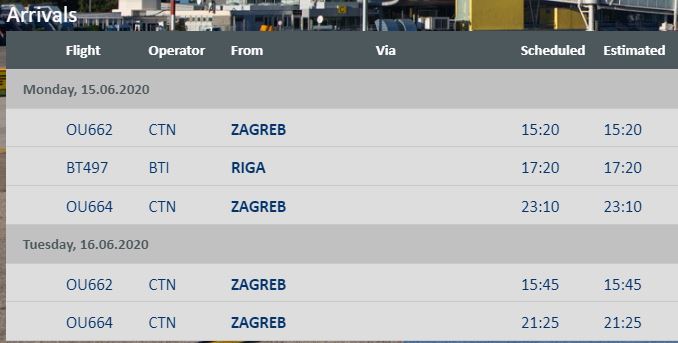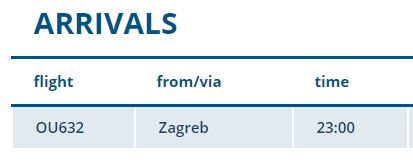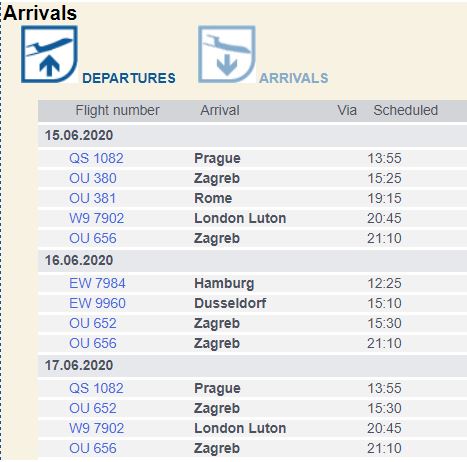Hvar Tests Rapid Temperature Check Tech from Varazdin in Corona Fight
June 16, 2020 - Some new rapid temperature check software developed by a Croatian company in Varazdin is tested on the island of Hvar - an outstanding tool in the battle against corona, especially against the second wave.
This would be absolutely perfect for the island of Hvar, was my first reaction when the technology was shown to me and explained.
Croatia's premier island, whose most famous son, Ivan Vucetic, discovered the art of fingerprinting. The wellness island where organised tourism in Europe began in 1868 with the Hvar Health Society. And an island which did an outstanding job keeping its citizens safe during the corona era. Just two cases recorded, both recovered, both from islanders returning from jobs in Austria.
Jelsa on June 12, 2020, the place where this little story began on Hvar.
Some days earlier, I was at home in Varazdin when my web developer, Bernard Toplak from Exabyte, invited me to the 9th birthday party of his favourite team, NK Varteks. The party was 75 metres from my front door, and we had things to discuss and he had something to show me.
As TCN wrote previously, Bernard has developed Croatian software with Chinese technology to produce a rapid temperature check measuring system at a distance of 5 metres, which can process 30-40 people at one time and flag anyone with a higher temperature. Bernard explains more in the earlier TCN article as well as in the video at the end of this article.
The uses are multiple - borders, ferries, catamarans, hotels, kindergartens, old people's homes, hospitals, restaurants, sporting occasions. After a successful 2-week trial in a Varazdin hospital, Bernard agreed to let me try it somewhere else.
And where better than Hvar, especially I could persuade Suncani Hvar Hotels to accommodate Bernard and his family while we tried it out.

I wrote to the Hvar police chief, the mayors of Hvar, Stari Grad and Jelsa, the Hvar and Stari Grad tourist board directors, and Suncani Hvar Hotels. Almost all replied enthusiastically. And so it was that Bernard and I arrived on Hvar to present the idea to the police chief, Hvar and Stari Grad tourist boards, Stari Grad mayor and Suncani Hvar Hotels, once Bernard had checked in to Hotel Riva.

It was a very lively chat, with plenty of questions from all sides.
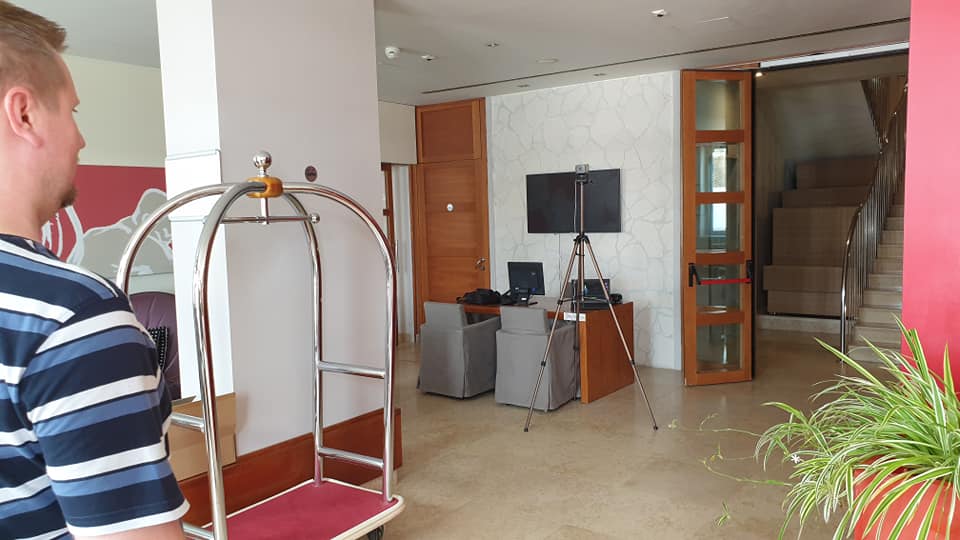
A quick demonstration in Hotel Riva before the main job the next day.

We started at the Stari Grad kindergarten, where national television was waiting.

And then to meet the team at the Stari Grad old people's home to demonstrate the system there.

The system identifies the head and measures the temperature under the eyes, producing a reading above the head of each person. And a red flag and alarm will appear for any high temperature. And the thermal imaging ensures no GDPR issues.
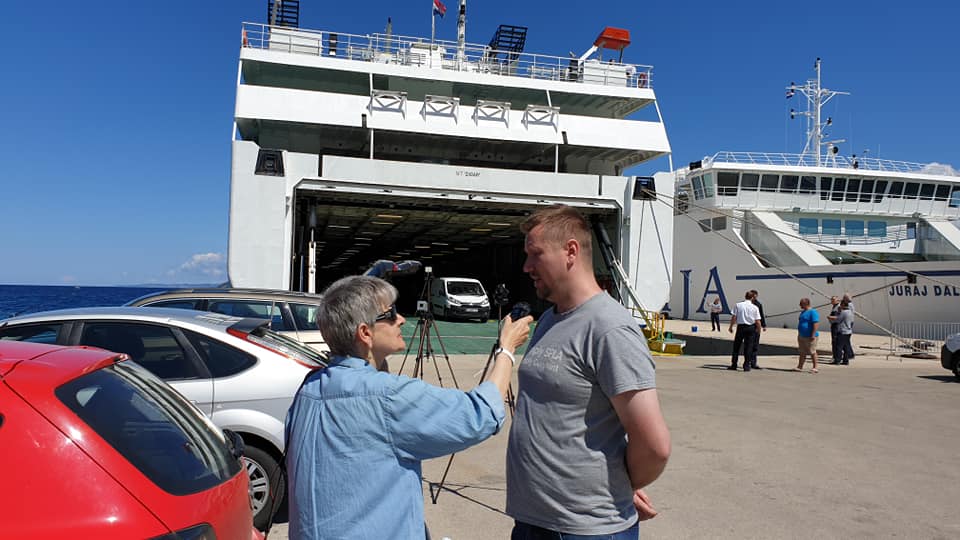
Next stop the Stari Grad ferry, where Radio Split took an interest.
Temperatures all ok on the 08:30 from Split.
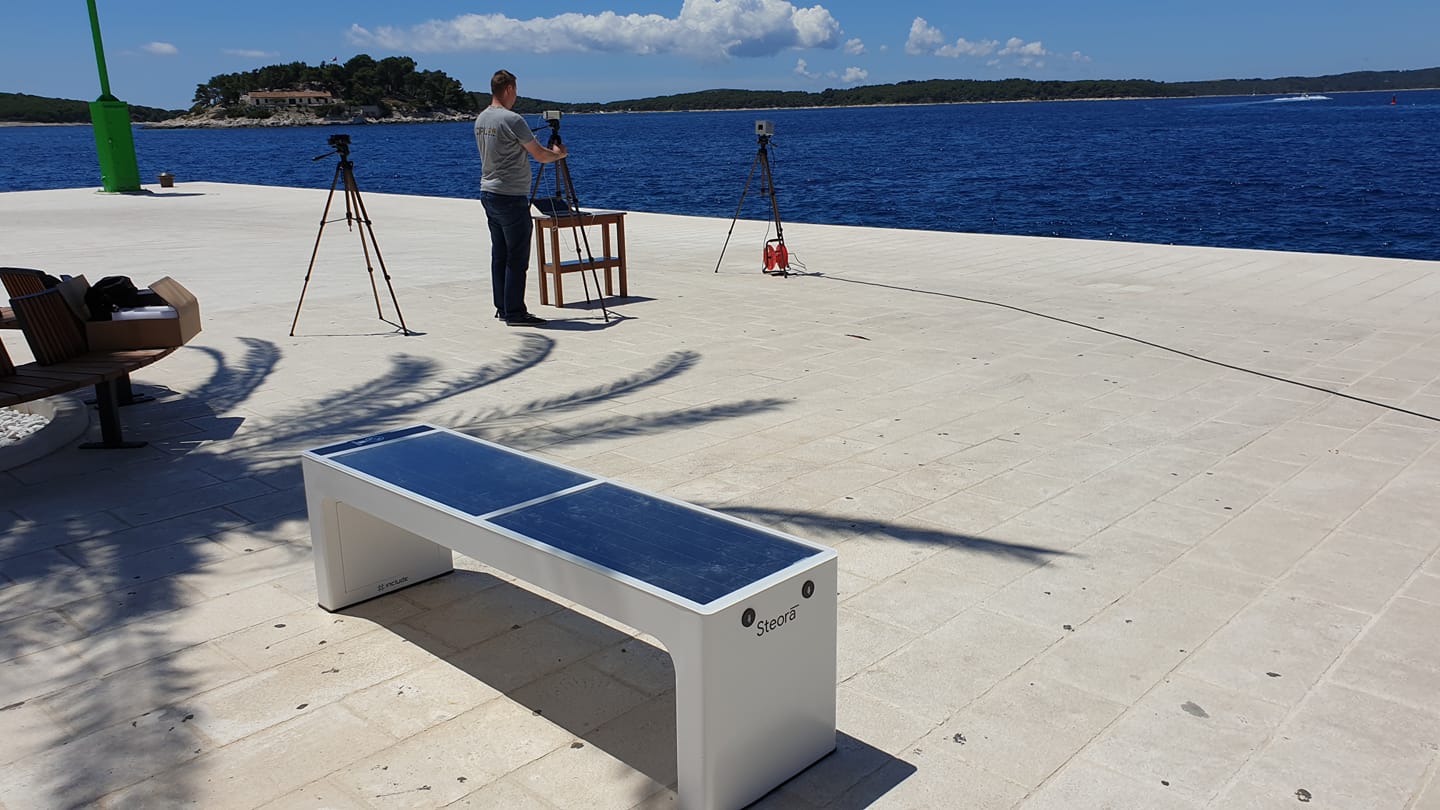
Time to set up on the exclusive Hvar Riva.
Healthy passengers on the 12:30 Krilo catamaran.
Back to Jelsa, where my day had begun to catch passengers on the 18:10 catamaran arrival from Split.
A fascinating day, and a great tool in the fight against corona, especially should a second wave come. You can find the TCN video report of the day and an interview with Bernard in English below.
If you are looking for more information about the system and applications, please contact This email address is being protected from spambots. You need JavaScript enabled to view it.
As Croatian Tourism Sector Cautiously Awakens, Tourism Minister Optimistic
The global (and ongoing) coronavirus pandemic has taken a toll on the world's tourism and Croatian tourism, which is the country's strongest economic branch, hasn't been immune from the beating it has been given. The economic consequences are harsh in their nature, and for the sector that makes up 20 percent of Croatia's GDP, is there any light at the end of the tunnel for 2020's season?
As Poslovni Dnevnik writes on the 15th of June, 2020, the Croatian tourism sector is slowly beginning to wake up once again. Four and five-star hotels, as well as holiday homes and camps of a higher class are currently the best filled.
"The announcements are good, we're optimistic, there are more and more reservations being made every day, new guests are arriving every day, so we're hoping that everything will be fine," said Ilija Turic, the director of a hotel in Opatija.
"The announcements are very good, the rate of booking has been very good. We could expect 80 percent of the realisation of last year's traffic for July and August,'' the owner of the camp Biserka Komadina stated in a clearly optimistic manner.
Currently, the Slovenes and the Germans are the most numerous campers in Croatia giving the Croatian tourism sector a much needed spring in its step, however cautious that step might be.
"There's no fear, we're well acquainted with the epidemiological picture in Croatia and we came without even thinking about it, we also know the situation with the camp, it has been checked," said Franc, a guest from Slovenia.
"Everything is clean, you can always see the staff cleaning and washing the toilets, the environment... that's very good," said Michael, another guest from Switzerland.
The Croatian Tourism Minister, Gari Cappelli, also appeared very optimistic in front of gathered journalists in the coastal town of Opatija today.
"I'm sure at the moment, according to these first indicators, that in some counties, such as Primorje-Gorski Kotar and Istria, the results may be at the level of 40 percent," said the minister.
The first party called "Let the party begin/Neka party počne" was held on the famous Zrće beach, and the toll on the Krk bridge will be abolished from midnight onwards. On top of that, the popular Dalmatian city of Zadar is also slowly filling up.
“It’s not very far away from Germany and there’s no coronavirus here,” said Rebecca, a guest from Germany.
In Istria, many halved their prices this weekend.
"The attendance is excellent, I can tell you that we were visited by a lot of foreign tourists, as well as domestic ones," said Romina Celija from the House of Istrian Olive Oil.
Due to their locations, the Dubrovnik and Split areas generally depend on guests arriving by air. This is especially true for Dubrovnik and the extreme south of Dalmatia, which is cut off from the rest of the country by a small section of coastline owned by neighbouring Bosnia and Herzegovina - Neum. This involves crossing a non-EU border and re-entering Croatia once again shortly after.
Minister Cappelli predicts that stronger traffic, especially towards Dubrovnik and Split, will start up again at the tail end of this month. Whether the optimistic expectations of the minister will be fulfilled will be seen as early as the beginning of July.
For more on Croatian tourism, follow our dedicated travel page.
What Kind of Blow will Coronavirus Pandemic Deal Croatian Banks?
When talking about the economic consequences of the ongoing coronavirus pandemic, could Croatian banks be worse off when compared to other banks operating within the country's immediate region?
As Tomislav Pili/Poslovni Dnevnik writes on the 15th of June, 2020, small and medium-sized companies in Central, Eastern and South-Eastern Europe (CESEE) will face much stricter criteria in terms of being granted loans from banks this year, is one of the main conclusions of a study by the European Investment Bank (EIB).
In addition, the share of non-performing loans will start growing again, for the very first time since back in 2015. According to the research conducted, banks in the CESEE region will face the worst business environment since the 2007 and 2008 financial crises due to the coronavirus pandemic.
In the last six months alone, banks in Croatia's immediate region have witnessed a solid demand for loans, while providing somewhat looser lending terms. However, the EIB's survey of as many as 90 banks concluded that lenders expect a sharp decline in demand for financing, as well as a significant tightening-up of approval conditions and, accordingly, a decline in the rate of approved loans.
Banks expect that it will be primarily households who will first reduce their demand for credit/loans, and not so much the corporate sector. 64 percent of banks in Central, Eastern and South-Eastern Europe expect an increase in the rate of non-performing loans in the second half of 2020.
However, the existing loan portfolio as it currently stands is expected to begin to deteriorate once again, with 64 percent of banks expecting a rise in the rate of ''bad credit'' during the second half of this year.
As for Croatia, the EIB pointed out that on the eve of the coronavirus pandemic, the Croatian banking market could boast of solid profitability, given that in the last six months more than half of foreign banking groups have reported higher returns on capital.
Given that the overall impact of the pandemic still remains quite unclear, in the next six months, Croatian banks unfortunately expect their market dynamics to fall even below regional trends. This is in line with forecasts that Croatia will experience one of the deepest recessions in the entire region, with a worrying nine percent drop in GDP.
While retail lending will be strongly negatively affected by sinking personal consumption, higher demand may come from the extraordinary liquidity needs of companies that had to shut down during the pandemic, backed by fiscal stimulus as well.
In order for banks in the CESEE region to return to pre-crisis levels and to be able to finance the domestic economy, support through instruments such as the European Guarantee Fund will be crucial, according to EIB economist Debora Revoltella.
For more on Croatian banks, follow our lifestyle page.
International Media Confusion (Again) as Croatia Opens Its Borders to EU Citizens
June 15, 2020 - As Europe opens many of its internal borders, more international media confusion about the situation on Croatia's borders.
The day has finally arrived.
June 15, 2020, the day we have all been waiting for. The day when the EU was planning to announce it is reopening its internal borders.
I have a busy day of meetings, so I decided to wake up early to publish the official confirmation, as well as update the TCN daily travel update, which is also available in 24 languages.
Incredibly, I can't find an official confirmation anywhere, and I have looked really hard.
The international media confusion continues as a result, with many outlets reporting that most EU borders are now open, and Austria will be from tomorrow, leaving the drive across Europe to Croatia now relatively free. My impression is that Croatia's borders are now completely open to EU citizens, which is also the understanding of some, but not all of the international media. Here is a selection:
Croatia
Croatia will reopen its borders to all EU citizens, including from the UK, on June 15, with no obligation to quarantine.
Croatia opened its borders in mid-May without restriction to nationals from the Czech Republic, Hungary, Austria, Estonia, Latvia, Lithuania, Poland, Slovenia, Germany and Slovakia.
Other visitors from the EU/EEA, and the UK, could also visit from May 11, though restrictions were in place, including quarantine and proof of accommodation.
Croatia
The country opened its borders in mid-May without restriction to nationals from the Czech Republic, Hungary, Austria, Estonia, Latvia, Lithuania, Poland, Slovenia, Germany and Slovakia.
Croatia will reopen to the rest of the E.U. and to U.K. citizens on June 15, with no obligation to quarantine. All arrivals should fill out a form online in advance and proof of a tourist accommodation booking is required on entry.
Parks, beaches, shops, museums, hotels and outdoor restaurants and bars are open, public transport is operating as well, as are some international and domestic flights. International flights are expected to increase throughout June.
(TCN comment - Although I respect Forbes very much, this does not make a lot of sense. Croatia has been open to EU citizens with proof of paid accommodation for weeks, with no quarantine requirement. If Croatia reopens its border to the rest of the EU and UK, that means that the borders are open, with no need for proof of paid accommodation. It is not the fault of Forbes here, just the astounding lack of clear communication from the tourism chiefs).
Croatia
Are the borders open? Yes. In an effort to get the tourism sector moving again, travelers from Austria, the Czech Republic, Estonia, Germany, Hungary, Latvia, Lithuania, Poland, Slovakia and Slovenia are allowed in without conditions, though the government says it will collect contact data. Nationals of other EU countries will have to show they have a good reason, although an accommodation booking will be sufficient.
Do arrivals have to quarantine? No, unless they have symptoms.
(TCN comment - Again, if the borders are fully open to all 31 EU/EEA countries, there should be no need for proof of accommodation. The situation described by Politico is the situation last week, and if this is the situation today, this means nothing has changed).
Interestingly, the New York Times wrote a comprehensive article on EU borders reopening, looking at a dozen individual countries, but did not mention Croatia at all. Presumably it was too hard to fact check the situation with no official information.
I expect the situation to be clarified today, but my current advice would be to have proof of paid accommodation and fill in the entercroatia.mup.hr form.
07:00 Update - I checked with an official at the ministry who told me that the National Civil Protection Headquarters would make the decision today.
So who is flying? Again, it is hard to find the information, so I checked with the airport arrivals pages of Croatia's main airports, as well as this month's schedule of Croatia Airlines.
Zagreb is the busiest airport, with Croatia Airlines connecting the Croatian capital with a number of European cities.
More flights tomorrow, including a direct flight from Dublin, as well as Air Serbia from Belgrade.
Dubrovnik is fairly quiet, with Riga the only advertised international connection in the next two days on the arrivals board.
Zadar is welcoming domestic flights only it seems.
And Pula has just the one flight from Zagreb today.
Not so many flights to Split either, but something of a surprise - a direct flight to the UK with Wizzair from London Luton.
I went to the Wizzair site to see if it was really happening, and it appears to be. With tickets still available. So if you feel like spending the night in Split tonight, book your ticket and come.
I suspect all this confusion will clear up in the next 24 hours. If, as I suspect, Croatia's borders are fully open to EU/EEA citizens, then the paid accommodation requirement should no longer be valid.
Compare these flights with Athens Airport today. Greece sent a very clear message that it would be opening for tourism today. In addition to dozens of domestic flights to its islands and other destinations, Athens will be welcoming flights from Frankfurt, Liege, Paris, Bucharest (2), Doha (2), Amsterdam, Rome, Vienna (2), Munich, Larnaca (2), Sofia, Tirana, London (2), and Milan.
For the latest updates, follow the TCN daily Croatia Travel Update, or join the Total Croatia Travel INFO Viber community and have your questions answered in real time.
Croatia 6th in Europe for Number of Anti-Coronavirus Measures
As Frenki Lausic/Novac writes on the 12th of June, 2020, according to an analysis undertaken by the European Systemic Risk Board (ESRB), based on published data on measures taken by national regulators in response to the ongoing coronavirus pandemic, Croatia exceeds the European average with about 40 measures, meaning it ranks in sixth place out of a total of 30 countries in the European Economic Belt.
This information was published by the Croatian Financial Services Supervisory Agency (HANFA). This week, their council discussed the review of financial stability measures taken across the European Union due to the coronavirus pandemic, as well as Hanfa's measures and recommendations which were issued to Croatian companies.
At the European level, it has been pointed out, most of the measures related to the non-financial sector are aimed mainly at companies, and in the financial sector they're aimed at credit institutions, securities and markets, as well as at the insurance sector.
Croatia is one of the nine European Union member states, as they emphasised from Hanfa, which, among other measures, adopted a measure on the temporary ban on the payment of dividends for insurance companies and is among the countries with the largest number of measures taken out with the insurance sector in mind. It's also worth noting that the Croatian National Bank (CNB/HNB) was the first in the entire EU to make a decision to ban the payment of dividends to banks this year.
The report notes: "after looking at the review of these measures, especially those in the financial sector, it can be concluded that Hanfa's measures and recommendations aimed at the Croatian non-banking financial sector and their users were adequate and timely.
"However, the economic consequences of the coronavirus pandemic on the domestic and international financial markets are still incalculable. However, the current data shows the first signs of recovery - from the return of investors' payments into investment funds to the increase in the assets of mandatory pension funds that returned to the levels before the global coronavirus crisis in Croatia,'' reads a statement from Hanfa.
It has also been added that Hanfa will continue to act in accordance with the guidelines of the European Systemic Risk Board, but also make additional independent recommendations (such as recommendations for a moratorium on leasing companies), depending on the development of the economic situation here in Croatia and the impact on both international and domestic financial services.
For more on coronavirus in Croatia, follow our dedicated section.
Coronavirus: Are Dubrovnik's Expensive Glory Days Over? Maybe...
Coronavirus has dealt global travel and tourism a huge blow, and even the City of Dubrovnik, which prides itself on tourism and is known for coming with a hefty price tag for just about everything, is suffering.
Dubrovnik is known for being the first to abolish slavery, its glorious Medieval walls, its UNESCO status, and its often extortionate prices. While it is true that there are many places in Croatia's southernmost city that are inexpensive (or at least there used to be, I live in Zagreb and it's been a while since I lived in the country's tourist Mecca), the most common complaints about Dubrovnik are the traffic and the price of things. Could coronavirus mark the end of that long-lived trend? Maybe...
As Poslovni Dnevnik writes on the 12th of June, 2020, the coronavirus pandemic has dealt a severe blow to tourism, even to Dubrovnik, which is also the primary economic branch from which Dubrovnik exists, and the dire numbers speak for themselves. According to the data of the Tourist Board of the City of Dubrovnik, on June the 1st, 2020, 86 arrivals and 316 overnight stays were recorded in the area of the City of Dubrovnik. For comparison, on the same day last year, there were 6,747 arrivals and 18,481 overnight stays realised, which are incomparably higher numbers.
In the city where almost every street has its own catering and hospitality facility, only about 50 of them are currently open. Currently, only seven of Dubrovnik's hotels have opened their doors to guests. These are the Dubrovnik Palace, Hilton Imperial, Hotel Lero, Hotel Park, Hotel Petka, the Pucic Palace and Royal Blue.
The president of the Dubrovnik County Chamber, Nikolina Trojic, revealed that the value of issued invoices in the tourism sector fell by an enormous 92 percent.
"According to the Tax Administration, from February the 24th to May the 17th, 2020, 78 percent fewer invoices were fiscalised than in the same period back in 2019, and the total amount of these invoices is 63 percent lower in all activities across Dubrovnik-Neretva County. In the tourism sector, which includes accommodation, catering/hospitality and travel agencies, the value of issued invoices fell by 92 percent,'' Trojic told the local Dubrovnik portal, Dubrovacki Dnevnik.
Although a work ban was in place for most industries, trade and traffic were the few that could still work. However, no positive figures were recorded in these sectors either.
"The data shows that the number of invoices issued in the trade sector was 41 percent lower, while the value of those invoices issued in trade was 27 percent lower. Among the most affected activities was the activity of travel agencies, where, during these observed three months of ''lock down'', the value of issued invoices fell by 98 percent compared to the same period back in 2019. Additionally, for the period from May the 11th, when caterers and those in the hospitality industry were allowed to work again, until May the 17th, 2020 (when compared to the same period in 2019) there was a decrease in the number of issued invoices by 71 percent and a decrease in the value of those same invoices by 96 percent in the tourism sector,'' Trojic explained.
Although the problem of labour shortages in tourist-oriented Dubrovnik used to exist because of demographic issues, now the priority has become to keep hold of these people and preserve the ability to pay their salaries.
"The absence of tourist figures from previous years will certainly have consequences for our economy. The reduced levels of demand for accommodation services, catering services, excursions and other tourist facilities will affect the downward price correction, it's an economic fact, the law of supply and demand. The fall in prices will depend on the level of indebtedness of economic entities and the possibility of servicing fixed costs.
Care should be taken to keep the value for money, because in the coming years that will be the biggest engine of recovery of our economy. It's to be expected that at some point, there will be a reduction in salaries, a reduction of the working week and other mechanisms for preserving these jobs,'' concluded Trojic.
For more on the Croatian economy and tourism in the coronavirus era, follow our lifestyle page.
Some Croatian Companies Return Aid, Others Refuse to Pay Employees
As Lucija Spiljak/Poslovni Dnevnik writes on the 13th of June, 2020, due to the ongoing coronavirus pandemic, a number of Croatian companies and employers have applied for government aid to preserve jobs in coronavirus-affected activities.
The aid, which comes as part of a special government measure, is intended for sectors whose business cannot be opened for objective reasons and for those which have experienced a (proven) decline of more than 50 percent, which relates to the terms of extended aid for June (it was previously intended solely for March, April and May, when it referred to a decline of more than 20 percent), given that the planned support was for three months - March in the amount of 3250 kuna and for April and May in the amount of 4000 kuna.
However, Croatian economic activity has been disrupted in the vast majority of industries, so the Croatian Employment Service's Board of Directors introduced a form of job preservation support for the month of June this year and amended the criteria for May 2020. For June, Croatian companies and other beneficiaries must submit a new application via the online application by June the 30th, although they'll have already used the aid, and the amount of the subsidy will be 4000 kuna.
According to the CES, the deadline for the payment of this support is the 20th of the month for the previous month, and in the case of Croatian employers having hired new employees in the meantime, no further government support can be requested for them.
According to the data received from the CES, by June the 6th this year, more than two billion kuna in support had been paid out for 98,432 employers and 526,876 workers in April. However, many Croatian companies complained that the requested funds, which were granted to them, arrived late, and out of a total of 113,396 received applications for support, a total of 6508 applications were rejected by the same date throughout the whole of Croatia.
The reason for the refusal is listed as the non-compliance with the defined conditions and criteria.
"Although the deadline for the payment of support to beneficiaries for the previous month is the 15th of the month, due to the large amount of data and delays in submitting documentation in some cases, the control process takes longer than what was originally planned and therefore the payments are arriving more slowly than we expected. Namely, given that the condition for the continuation of the payment of support is the delivery of proof of payment of employee salaries for the previous month for all workers for whom the support was paid out, the Institute conducts detailed controls by matching data with the Croatian Pension Insurance Institute and the Tax Administration,'' they claim from the CES.
To briefly recall, the target groups of Croatian companies and employers eligible for the payment of this support are employers in the sectors of agriculture, forestry and fisheries, transport and storage, accommodation and food and beverage service activities, administrative and support service activities, organisers of various public events and ancillary activities such as companies who deal with equipment rental, audio and video recording, ticket sales, hall rental, along with other companies that generate most of their revenue from events and public gatherings.
The CES also lists Croatian companies, crafts, family farms and natural persons who are independent contractors and self employed individuals as eligible business entities. The CES also reports that they are continuously monitoring the situation on the domestic labour market along with the Ministry of Labour, on the basis of which the need to extend the implementation of this particular economic measure will be further considered.
Given the fact that Croatian companies have stabilised their operations with the easing of the formerly stringent anti-epidemic measures, some have decided to repay the financial aid they received from the government for three months - 973 Croatian companies have made that choice.
There is a brewing problem among Croatian companies and employers who have applied for benefits, had them granted, but have not paid their employees their salaries.
The list from the Tax Administration includes a total of 1237 Croatian companies/employers - of which 1185 are legal entities and the rest of 53 are obrtnici (owners of crafts), who haven't paid out employee salaries for a total of 2310 workers they employ.
This concerning data on the literal non-payment of wages is based on submitted JOPPD forms in which employers reported the non-payment of wages for the period from January to March this year. The first list of non-payers of salaries was published by the Tax Administration way back on July the 15th, 2014, and it included 5,619 legal entities that hadn't paid salaries to 19,449 workers during the first quarter of 2014.
The conclusion is that since 2014, since the lists of non-payers were published, the number of non-payers has decreased by almost five times, and the number of non-payers for only one worker (probably the owner of the entity paying themselves) has increased. Worryingly, tsix activities that are on the list of non-payers are also in the top eleven activities that received the largest payments of government aid for the month of March.
For more, follow our business page.
New Bonds Cover Old Debt and Cost of Croatian Government Crisis Measures
As Novac writes on the 12th of June, 2020, when panic broke out over the outbreak of the coronavirus pandemic, the Croatian Government and more specifically the Minister of Finance found themselves in the most difficult situation imaginable: an incalculable abyss opened up in the budget and in just a few days, the good fiscal results that had been worked on for years were quite simply kicked to the dust and erased by the consequences of the virus.
However, if we can even dare to begin talking about a V-shaped recovery at this moment in time, then the closest to it is fiscal policy. Minister Zdravko Maric first reported that revenues in May were about 50 percent lower than they were during the same month last year, which is an enormous and concerning drop, but it was still much smaller than what was originally expected - a drop of up to 70 percent was expected. Further improvement is expected in June. Then came the positive reports from various credit rating agencies, and finally, very successful borrowing on the international capital market began.
On Wednesday, the finance ministry issued two billion euros worth of bonds for a period of eleven years and an interest rate of 1.5 percent (a yield of 1,643 percent), which is "as much as 45 basis points lower than the initially announced price."
The interest of the investment community, they say from the Ministry of Finance, "was exceptional", about 400 investors came forward, including those who invest exclusively in investment credit rating bonds. Their demand was 8.45 billion euros, about 4.2 times the nominal amount of the issue.
Financial analyst Andrej Grubisic says that Minister Maric is just doing his job, and he expects nothing but good results from him because he has been in the Ministry of Finance for years "and belongs to the category of the best to have done that job".
Although he doesn't dispute his expertise and the results achieved by the Croatian Government, and once again with an emphasis precisely on Zdravko Maric, he points out that the circumstances also helped him out a little. This, above all, refers to the large inflow of money which results in low interest rates. However, it also carries a certain danger that a large amount of money in circulation will raise inflation.
The Ministry of Finance plans to use this borrowed money to refinance the 1.25 billion US dollar bond, which matures in mid-July this year and was issued back in 2010 at a price of 6.625 percent. This also means that the new indebtedness brings budget savings of around 360 million kuna for the Croatian Government. The remaining 750 million US dollars, according to the Treasury, "will be used to fund measures to help the economy affected by the coronavirus pandemic, as envisaged in the amendments to the state budget for this year."
With the latest borrowing on the international market, the Ministry of Finance has largely solved this year's financial needs of the budget, which, due to the coronavirus pandemic, increased from 30.5 billion kuna to a massive 63.4 billion kuna. With the budget revision back in May, the Croatian Government has significantly reduced expected budget revenues this year (by around fifteen per cent) and it expects a general government deficit of 6.8 percent of GDP, after last year’s surplus of 0.4 percent.
Agencies that have assessed Croatia's creditworthiness in recent weeks expect that the situation could return to the much talked about Maastricht framework as soon as next year, with a budget deficit of 2.7 percent of GDP. As a positive aspect of the fiscal situation, Fitch states that the needs for the financing of the budget in the medium term are moderate, given that the extended maturity of bonds is close to six years, and it assesses that "debt management is prudent".
An additional mitigating circumstance in the coming years should be favourable financing conditions and less need for borrowing on the market, as Croatia could become one of the biggest winners of the European aid programme, which regards around 10 billion euros in the period from 2021 to 2027, with 7.3 billion euros set aside for grants.
For more, follow our lifestyle page.
First Signs of Reactivation of Croatian Economy Possible This Month?
Could June bring the reactivation of at least part of the enfeebled Croatian economy with it, along with some warm weather? Statistics, although cold, provide a glimmer of hope.
As Novac writes on the 12th of June, 2020, the seven-year recovery period for the European Union's labour market has been abruptly stopped in its tracks by the economic turmoil caused by the coronavirus pandemic, and unemployment has risen in almost all member states.
The seasonally adjusted unemployment rate for most EU27 members rose back in March, but at the level of the EU27 average itself, it remained the same as in the previous month (6.4 percent), which was also the lowest rate in twelve entire years. The unemployment rate continued to fall and was 98,000 lower in March than it was in February.
In April, the disruption was stronger due to the month-long economic ''closure'' of almost all EU member states, and the total number of unemployed people rose by 398,000 to a concerning 14.1 million. The unemployment rate rose in all member states except Italy and Denmark, which resulted in an increase in the rate at the EU27's level to 6.6 percent.
However, compared to the same month last year, both the number of unemployed people and the unemployment rate across the EU27 remained lower than it was in April, although only a few member states had a lower rate - Denmark, Poland, Portugal and Finland.
The highest rate decline was recorded in Italy (by 3.9 percentage points), which had a strong impact on the EU27 average. However, the decline in the unemployment rate in Italy was based on a sharp decline in the participation rate, rather than on employment growth itself. Namely, Italy, due to its sheer size, significantly affects the EU average. The unemployment rate there fell in both March and April, but with a simultaneous reduction in the number of employees and a sharp decline in labour market participation by more than three percentage points.
The drop in the participation rate is a result of the fact that a significant number of people postponed active job searches due to the terrible Italian epidemiological situation, so they were recorded as inactive during these two crisis months and not actually as unemployed, which means that unemployment growth was probably postponed a little.
According to these Eurostat statistics, Croatia was the third largest member state when it comes to the highest employment growth during the first quarter, but it was also among the member states in which the seasonally adjusted unemployment rate rose in March, it was also among those where it rose sharply in March and April (in March by 0.6 percentage points, and in April by 1.3 percentage points).
Thus, the Croatian economy managed to gain a slightly worse position in the EU27 during the crisis months of March and April - in April it had the seventh highest rate, while just before the start of the pandemic (in February) it had the tenth highest rate in the EU27. As such, it moved away from the EU27 average, to which it was very close last year and at the beginning of this year.
Although the positive developments on the EU's labour market were interrupted in these extraordinary circumstances caused by the ongoing coronavirus pandemic, this increase in unemployment in the most critical months so far was actually below expectations. Namely, it can be concluded that the measures taken by EU member states, which were mostly mostly focused on job retention, significantly mitigated the growth of unemployment.
Namely, the unemployment rate was expected to exceed 8 percent in April, and it was still kept at a lower level of 6.6 percent (although this was partly a reflection of the decrease in labour market participation, which affected the decrease in the number of registered unemployed people).
At the same time, when labour market developments across the EU are compared with those across the Atlantic in the US, a huge difference can be easily seen, which can still be attributed to the effects of the measures taken by countries since March.
Across the pond in the USA, which didn't focus its measures on preserving jobs, the unemployment rate rose by 0.9 percentage points in March, and by a shocking 10.3 percentage points in April, to the highest level (14.7 percent) since the devastating Great Depression. However, positive changes were visible in May, with the rate falling to 13.3 percent, the number of unemployed decreased by more than 2 million (to 20.98 million), and the number of employees increased by 3.8 million (to 137.2 million).
Administrative data on unemployment in Croatia currently shows a good short-term trend given the dire circumstances. Namely, the number of unemployed people on June the 10th, 2020, stood at 153,467, which was 4,372 less than at the end of May and 5,767 less than at the end of April.
As the trends changed after the introduction of the wage subsidy of 4,000 kuna, it should be expected that unemployment will move until the implementation of the government-introduced measures comes to an end.
Data for the first ten days of June provide a much needed glimmer of hope that the reactivation of the Croatian economy may come more quickly than was previously expected, because in those ten days of June - 8,842 people from the Croatian Employment Service's records were stated as being employed (mostly in tourism, trade and manufacturing), which is at the level of 89 percent of employees throughout May.
Since Croatia has already opened its borders to its most important emitting tourist markets, and Germany and Austria are expected to lift their respective travel restrictions from the 15th of June, it would be fair to expect this to have an immediate positive impact on Croatian tourism and then indirectly on the Croatian economy and as such, on the labour market.
For more on the Croatian economy, follow our business page.
Interior Ministry Answers 10 Most Commonly Asked Border Questions
June the 13th, 2020 - the Croatian Interior Ministry (MUP) has provided answers to the most commonly asked questions by those wishing to cross Croatia's borders in the confusing coronavirus era.
Earlier this week I went on a truly fascinating tour of the Croatian border control system, after the Interior Ministry granted my media request to do a feature story on the whole border procedure, especially how the new entercroatia.mup.hr form was speeding up the system. It was a fascinating tour, which you can read about in full here.
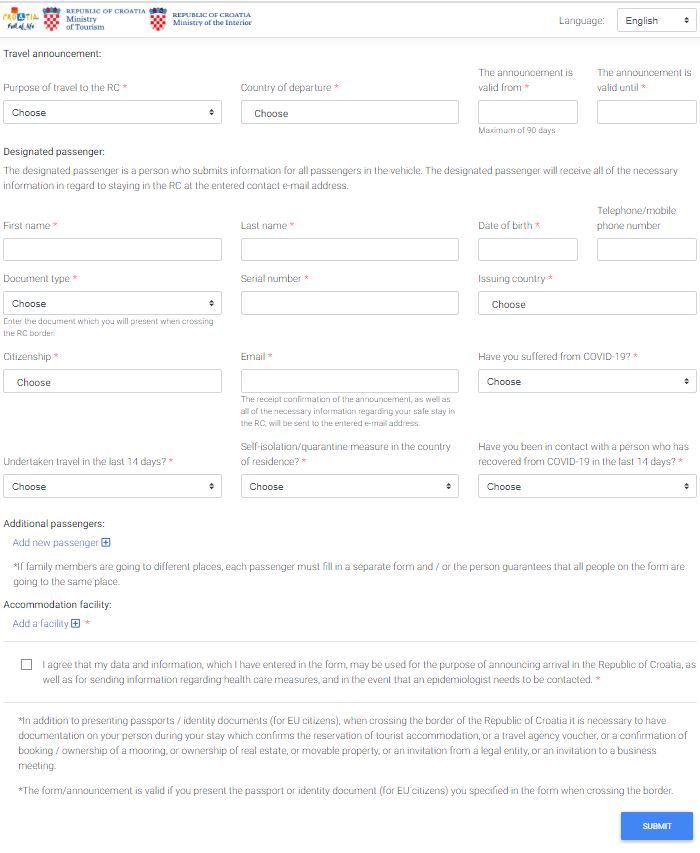
I was particularly interested to meet the team answering all the tourist emails at the official email address provided, and I was more than a little surprised to learn that in a tourism county with a national tourist board, 20 regional tourist board, 319 local tourist boards, a Ministry of Tourism and a tourism sector of the Chamber of Economy, all the questions are being answered by...
... the Croatian police.
The team answering the emails are incredibly dedicated. With some 28,000 emails to answer at the time of my visit, they pulled in police departments all over the country, so it is quite possible that your email asking about flights to Split might be answered by the police in Osijek. A crazy situation, and I offered TCN help if the police were interested.

Firstly I showed the team the TCN travel update, and invited them to either send the link or paste the relevant info.
They were having trouble with foreign language enquiries, so I showed the travel update in 24 languages.
And finally, we compared notes on FAQs when I showed them the Viber community, Total Croatia Travel INFO.
I suggested that they send me the top 10 most-asked questions with answers, and then we would translate and share, in the hope this would reduce the email flow. Am grateful to Lauren Simmonds for the translation - you can see the questions and answers below.
Here are few other things I learned and would recommend.
1. If your questions is tourism-related and not regarding procedures to enter the country, you should contact the Croatian National Tourist Board instead - This email address is being protected from spambots. You need JavaScript enabled to view it.. They are generally very responsive.
2. If you want your question answered quicker, make it as easy as possible for the police to answer it. People are sending their questions in Hungarian, Portuguese and many other languages. The police can comfortably deal with queries in English, German and Croatian. Anything else will lead to a delay.
3. EVERY foreigner entering Croatia is advised to fill in the entercroatia.mup.hr form. The reason is that the border crossing experience is then reduced to just 30 seconds (one scan of the passport). If not, a lot of the accommodation and contact details need to be filled in manually. I saw the system in action close up - it works superbly.
4. Please read the comprehensive FAQ provided by the Interior Ministry before sending your email request. Apart from not overburdening the system, you will probably find your answer quicker.
Here are the questions and their answers in full:
1. I'm a citizen of Bosnia and Herzegovina, can I transit through the Republic of Croatia? I'm arriving by plane which will land at the Franjo Tuđman International Airport in Zagreb and I'd then travel by bus to Bosnia and Herzegovina. May I do that? Or can my friend from Banja Luka come for me?
Transit through the Republic of Croatia when returning to your home country is allowed, however, your friend will not be allowed to enter the Republic of Croatia because he isn't allowed to enter for the stated purpose.
2. I'm a German citizen, can I enter the Republic of Croatia as a tourist, and if so, what documents do I need to show?
Citizens of 10 member states of the European Union (Czech Republic, Hungary, Austria, Estonia, Latvia, Lithuania, Poland, Slovenia, Germany and Slovakia) don't have to provide any reason for their entry when entering the Republic of Croatia, they can enter the country under the same conditions as before the onset of the COVID-19 pandemic, but still with epidemiological controls in place, and with the obligation to comply with the general and special recommendations of the Croatian Institute of Public Health. Foreigners who have an authorised stay (legal residence) in these countries can also enter the Republic of Croatia without proving their reason for entry, but they must show their residence permits.
To reduce congestion at border crossings and shorten the waiting times when crossing borders, we recommend foreign nationals who intend to stay in the Republic of Croatia to submit their data in advance via the website entercroatia.mup.hr. People who don't submit their details in advance via this application will still be able to do all this at the border crossing when entering Croatia, but that will imply a longer waiting time and in a separate lane.
3. Do I need a COVID 19 test for entry/transit into the Republic of Croatia and do I need to go into self-isolation when in the Republic of Croatia?
A COVID-19 test is not required to enter the Republic of Croatia. When entering the Republic of Croatia, there is no need for self-isolation now, but persons must adhere to the general and special recommendations and instructions issued by the Croatian Institute of Public Health.
4. I'm a foreigner, but I would be visiting my parents/brother, etc. Can I do that?
For family members of a Croatian citizen who don't hold Croatian citizenship (meaning they hold the citizenship of a EU/EEA country or that of a third country), entry is allowed with proof of kinship (a birth certificate, a marriage certificate, or a certified declaration of cohabitation).
5. I'm a foreigner, but I'm in an relationship with a Croatian citizen (engaged to one), can I enter the Republic of Croatia to visit him or her?
You will be allowed to enter the Republic of Croatia if you show a certified statement at the Croatian border that you're in this type of relationship with a Croatian national and that you intend to get married.
6. I'm coming to Croatia on business, what do I need to enter, and can my wife come as well?
You will be allowed to enter if you have an invitation letter from an economic operator from Croatia or another type of confirmation of your economic interest in the Republic of Croatia, or if you're the owner of an economic entity in the Republic of Croatia. Your wife can come with you if she is also listed in the invitation letter, and if you're the owner of an economic entity, entry is allowed but you must present a marriage certificate.
7. In Croatia, I have a scheduled check-up/medical procedure/operation, and I'm a citizen of a third country. What do I need to provide in order to enter?
You will be allowed to enter the Republic of Croatia if you show a certificate at the border that you have an appointment for a check-up, medical procedure, etc in a healthcare institution in the Republic of Croatia.
8. I live in Switzerland, I paid for a holiday on Korcula. What do I need to enter Croatia?
Foreign nationals who have proof of paid accommodation or a reservation for an apartment/hotel, a lease agreement for a camp, the reservation of a plot in a camp, the rental of a tourist boat or sailboat, or paid or arranged tours in the Republic of Croatia, as well as in the entire other spectrum of tourist activities, are allowed to enter the Republic of Croatia.
When entering the country, it is necessary to show the confirmation of you having booked tourist accommodation. To reduce congestion at border crossings and shorten the waiting times, we recommend foreign citizens who intend to stay in the Republic of Croatia to submit their data in advance via the website entercroatia.mup.hr.
Passengers who don't submit their details in advance through the aforementioned application will still be able to do all of this at the border when entering the Republic of Croatia, but it will take longer and they'll need to wait in a separate lane.
9. I need to transit through Croatia to Bosnia and Herzegovina, but along the way I'd be stopping at a friend's house in Rijeka. Is that allowed?
After entering the Republic of Croatia, you must leave the territory of the Republic of Croatia by the shortest route without unnecessary hanging around and performing other tasks because you have no justifiable reason to enter the Republic of Croatia, you're only allowed transit.
10. I come from the United Kingdom and have a house in Zadar. I'd be bringing two friends with me, will they be allowed to enter?
Foreigners who own property in the Republic of Croatia and their immediate family members are allowed to enter with proof of ownership of property and proof of kinship. Friends will not be allowed to enter because they are not eligible to enter for this purpose. They will be allowed to enter if they have a confirmation of having booked tourist accommodation in Croatia.
For the latest travel info, bookmark our main travel info article, which is updated daily.
Read the Croatian Travel Update in your language - now available in 24 languages
Join the Total Croatia Travel INFO Viber community.
Translation by Lauren Simmonds.


